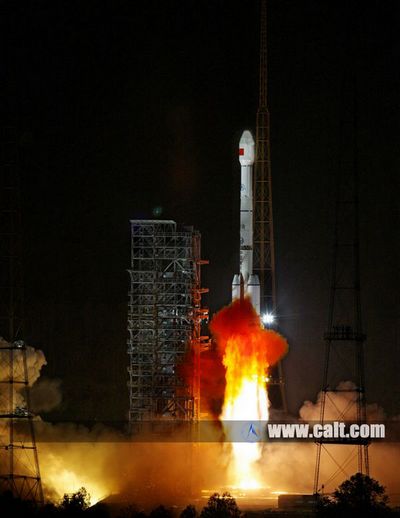China Launches New Communications Satellite Into Orbit

A Long March 3B rocket lifted off Saturday and successfully deployed a Chinese military communications satellite bound for an orbit over the equator, state media reported.
The 185-foot-tall launch vehicle, weighing about one million pounds, blasted off at 1556 GMT (11:56 a.m. EDT) Saturday from the Xichang space center in southwest China's Sichuan province. Launch was at 11:56 p.m. Beijing time.
The Long March 3B/E rocket flew with an enhanced first stage and liquid-fueled boosters. The three-stage rocket released the Chinasat 2A payload in an oval-shaped transfer orbit ranging in altitude from 129 miles to about 22,240 miles.
The Chinasat 2A spacecraft will circularize its orbit about 22,300 miles over the equator, where its speed will match the rate of Earth's rotation, making the satellite appear to hover over a fixed position.
The Xinhua news agency reported the satellite was built by the China Academy of Space Technology. The craft is likely based on China's DFH-4 satellite platform, China's most powerful standardized platform for communications missions.
According to Xinhua, the Chinasat 2A satellite "will be used to meet the demands for China's radio and TV broadcasting and broadband multimedia transmissions."
But analysts believe the satellite will serve with Chinese military with on-the-move communications.
Get the Space.com Newsletter
Breaking space news, the latest updates on rocket launches, skywatching events and more!
Saturday's liftoff was the eighth space launch of the year for China, and it marked the 28th launch to reach orbit worldwide in 2012.

Copyright 2012 SpaceflightNow.com, all rights reserved.
Join our Space Forums to keep talking space on the latest missions, night sky and more! And if you have a news tip, correction or comment, let us know at: community@space.com.
Stephen Clark is the Editor of Spaceflight Now, a web-based publication dedicated to covering rocket launches, human spaceflight and exploration. He joined the Spaceflight Now team in 2009 and previously wrote as a senior reporter with the Daily Texan. You can follow Stephen's latest project at SpaceflightNow.com and on Twitter.










